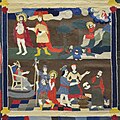Category:Ecce homo
episode in which Pontius Pilate presents Jesus Christ to the people, from the Latin words used by Pilate in the Vulgate translation of John 19:5 | |||||
| Upload media | |||||
| Instance of |
| ||||
|---|---|---|---|---|---|
| Part of | |||||
| Dedicated to | |||||
| Author | |||||
| Present in work |
| ||||
| Religion or worldview | |||||
| Different from | |||||
| |||||
| Ecce homo | Man of Sorrows |
|---|---|
| Real story: balcony or stairs (or without background), Pontius Pilate, |
Imaginably (Isaiah 53:1-3): without background (or with open tomb), with angels |
| Christ is still alive, and his hands are tied, may hold sceptre. |
Christ is dead or resurected and his hands are with stigmata.
|
 
|
 
|
Ecce homo are the Latin words used by Pontius Pilate in the Vulgate translation of John 19:5, when he presents a scourged Jesus Christ, bound and crowned with thorns, to a hostile crowd. It follows the Flagellation of Christ, the Crowning with thorns and the Mocking of Christ, the last two often being combined. The usual depiction shows Pilate and Christ, the mocking crowd and parts of the city of Jerusalem. But, from the 15th century, devotional pictures began to portray Jesus alone, in half or full figure with a purple robe, loincloth, crown of thorns and torture wounds, especially on his head.
See also Category:Man of Sorrows = representation of Christ with the wounds of the crucifixion visible.
Subcategories
This category has the following 15 subcategories, out of 15 total.
Media in category "Ecce homo"
The following 60 files are in this category, out of 60 total.
-
'Ecce Homo' RMG PY5993-001.tiff 2,974 × 3,880; 33.01 MB
-
'Ecce Homo' RMG PY5993-002.tiff 2,971 × 3,865; 32.85 MB
-
02020 0212 (2) Equality March 2020 in Kraków.jpg 2,915 × 4,002; 2.27 MB
-
Annakapelle Kössen Ecce homo.jpg 1,957 × 2,234; 994 KB
-
Antonello da Messina, Ecce Homo, 1473.jpg 3,024 × 4,032; 5.73 MB
-
Behold the man.jpg 1,109 × 885; 554 KB
-
BEHOLD THE MAN.jpg 730 × 1,000; 460 KB
-
Berlin, Museum Europäischer Kulturen, Fleckelteppich NIK 0617.jpg 6,000 × 4,000; 10.63 MB
-
Bildstock4 Steinach.JPG 2,848 × 4,288; 6.38 MB
-
Capela do Senhor dos Remédios, Sardoal, Pilatos.jpg 480 × 640; 208 KB
-
Caravaggio - Ecce homo.jpg 1,862 × 2,560; 1.33 MB
-
Caravaggio - L'ECCE HOMO CORTEZ.jpg 1,578 × 1,164; 310 KB
-
Christ is paraded before the people wearing a crown of thorn Wellcome V0034561.jpg 2,752 × 2,540; 2.8 MB
-
Christ Presented to the PeopleDore.jpg 400 × 500; 38 KB
-
Dresden-Landgericht 022.jpg 4,000 × 6,000; 7.25 MB
-
Duchcov Husova 13 (5843).jpg 2,533 × 3,000; 3.76 MB
-
Duchcov Husova 13 (5845).jpg 2,000 × 3,000; 2.55 MB
-
Durer ecce-homo.jpeg 345 × 500; 23 KB
-
Ecce Homo Nikolaos Kallergis.png 402 × 1,178; 842 KB
-
Ecce homo, Constantin Meunier, 1890, Koninklijk Museum voor Schone Kunsten Gent, 1994-C.jpg 6,132 × 8,176; 20.86 MB
-
Ecce Homo, from The Passion of Christ MET DP820904.jpg 2,239 × 3,397; 3.22 MB
-
Ecce Homo, RP-P-BI-1896.jpg 3,388 × 4,456; 2.82 MB
-
Ecce homo, SK-A-4650.jpg 3,812 × 5,226; 3.35 MB
-
Ecce-Homo Statue 1882.jpg 3,468 × 4,624; 6.18 MB
-
Ecce-Homo Velez Escudo Oficial.png 225 × 225; 13 KB
-
Eccehomocarrero.jpg 1,242 × 1,697; 699 KB
-
Efstathios Karousos Eede O Anthropos.png 331 × 588; 512 KB
-
Email Limoges Ecce Homo makffm 15566.jpg 2,428 × 2,814; 3.16 MB
-
Epitafium Hansa Stegera-St. John Cathedral-Wrocław.jpg 986 × 1,280; 312 KB
-
Escudo Ecce-Homo.png 2,177 × 3,138; 2.03 MB
-
Espalion - rue de l'Ecce Homo 1.jpg 714 × 1,105; 294 KB
-
Espalion - rue de l'Ecce Homo 2.jpg 566 × 901; 223 KB
-
Fleckelteppich Quadrat 2 1.jpg 3,405 × 3,404; 8.61 MB
-
Fotoreproductie van Ecce Homo door Guido Reni, RP-F-F00701-11-2.jpg 1,676 × 1,496; 298 KB
-
Galeriewerk Woermann Mappe 05 12.jpg 10,120 × 14,679; 17.12 MB
-
Hugo-de-Groot-Daniel-Wilhelm-Triller-Der-Leidende-Christus MG 0313.tif 3,188 × 4,885; 44.59 MB
-
Jeremias-de-Decker-Jacob-Aertsz-Colom-J-de-Deckers-Gedichten MGG 0576.tif 3,384 × 4,752; 46.04 MB
-
Kapelle St. Jakob-Caplutta Sogn Giacun. Breil-Brigels (actm) 17.jpg 3,103 × 4,961; 6.17 MB
-
Laredo, cementerio 04.jpg 4,288 × 2,848; 10.97 MB
-
Littleofficeofpa00bona (page 19 crop).jpg 1,620 × 2,352; 1.08 MB
-
Luciano borzone, ecce homo.JPG 1,040 × 1,363; 955 KB
-
Mihálygerge, római katolikus templom belső tere 2024 09.jpg 1,600 × 2,400; 964 KB
-
Neustädter Kirchplatz 7, Neustädter Kirche Eschwege 20220301 0058.jpg 5,689 × 3,785; 14.68 MB
-
Neustädter Kirchplatz 7, Neustädter Kirche Eschwege 20220301 0061.jpg 5,140 × 4,398; 14.8 MB
-
Nuestro Padre Jesús de la Piedad.jpg 1,080 × 1,080; 99 KB
-
Print, The large "Ecce Homo", ca. 1610 (CH 18335551).jpg 3,174 × 2,294; 9.08 MB
-
Rembrandt - Le grand Ecce Homo, 6821 LR Recto.jpg 627 × 768; 185 KB
-
Rembrandt - Le grand Ecce homo, 6822 LR Recto.jpg 632 × 768; 199 KB
-
Retablo del Ecce Homo de la iglesia de Albares de la Ribera.jpg 2,113 × 2,952; 1.05 MB
-
S M in Monterone, Ecce Homo P1150239.jpg 1,920 × 2,560; 2.74 MB
-
Sankt Nicolai - KMB - 16001000014698.jpg 608 × 600; 85 KB
-
Santísimo Cristo del Ecce-Homo (San Gil) cuenca 2012.jpg 2,131 × 2,137; 1.69 MB
-
Santísimo Cristo del Ecce-Homo (San Miguel) cuenca 2012.jpg 2,301 × 2,877; 2.08 MB
-
ST 24 10 2018 07.jpg 720 × 960; 217 KB
-
St nizier eCce homo pilier 01390.jpg 1,535 × 2,806; 2.6 MB
-
The Church Army (18360912395).jpg 5,174 × 6,813; 4.68 MB
-
Tomar-Convento de Cristo-Capela dos Portocarreiros-Cristo zombado-20140914.jpg 3,751 × 5,303; 17.69 MB
-
W3028 Pontchateau Calvaire Scala Sancta4 EcceHomo1909 24893Eos.jpg 3,168 × 4,752; 3.65 MB
-
Wnętrze bazyliki w Fordonie-polichromia Chrystus Ecce Homo.jpg 2,299 × 2,299; 988 KB



























































